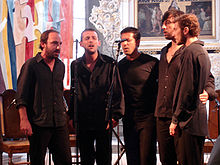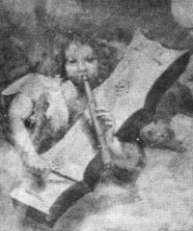3.2: Culture- History of Folk French Music
- Page ID
- 23107
French folk music
As Europe experienced a wave of roots revivals in the 1950s and 1960s, [1] France found its regional culture reviving traditional music. Brittany , Limousin , Gascony , Corsica and Auvergne were among the regions that experienced a notable resurgence in the popularity of folk music. Traditional styles of music had survived most in remote areas, such as the island of Corsica and mountainous Auvergne, as well as the more nationalist lands of the Basques and Bretons.
Folk music and dance now has an established place as a popular pastime in its own right with innumerable festivals, concerts and bals folks across France and a number of regular publications devoted to it.[2]
Auvergne
Auvergne is known for cabrette bagpipes. The cabrette (little goat in Auvergnat) is a bagpipe made of goatskin (goats being an integral part of Auvergnat traditional life) and without drones, blown by elbow-driven bellows. Some famous old players : Martin Cayla, Jean Bergheaud, Marcel Bernard, Antoine Bouscatel, Joseph Costeroste, Georges Soule, and some modern players: Dominique Paris, Victor Laroussinie, Didier Pauvert, Stéphane Charpentier, Michel Esbelin, François Lazarevic. They play both regrets(slow airs), bourrées (typical auvergne danse) and swift, 3/8 dance music.
Joseph Canteloube was a well-known composer from Auvergne in the early 20th century, and produced a famous collection of folk music called Songs of the Auvergne.
Béarn
Gascony
One of the biggest stars of the French roots revival was Perlinpinpin Folc, formed in 1972 and led by Christian Lanau, whose Musique Traditionelle de Gascognewas a popular release that sparked interest in the traditional music of Gascony.
Gascon small pipes, called boha (bouhe), are a well-known part of the local scene. They have a rectangular chanter and drone combination, which is unique to Gascony, and are made out of sheepskin with the fleece showing.
Languedoc
Languedoc is home to several unusual instruments, including the bodega, a kind of bagpipe, and the aboès and graille, both kinds of oboes. The bodega is made out of goatskin, using an unusual process in which the innards of the animal are removed through the neck so that the entire, unbroken skin can be used for the instrument. It has only one large shoulder drone. The bodega is known from at least the 14th century. Popular traditional groups from Languedoc include Calabrun, Trencavel, Laurent Audemard‘s Une Anche Passe and Trioc.
Limousin
Limousin is known for its violin music, as well as the chabrette bagpipe. Eric Montbel is the biggest star of Limousin folk, while Françoise Etay, Jean Pierre Champeval, Olivier Durif, Valentin Clastrier and Pascal Lefeuvre are also popular. Instruments include the cabrette bagpipe and the ancient army fife, pifre. Limousin violin music, focussed in Corrèze, has produced stars François Etay and Trio Violon, while more modern fiddlers include François Breugnot, Olivier Durif, Jean Pierre Champeval and Jean-François Vrod. The hurdy-gurdy in Limousin has been extended to avant-garde styles utilizing electronic music, jazz and other influences, including Pascal Lefeuvre, Dominique Regef and Valentin Clastrier.
Provence and Alps
Roussillon
The southwestern region of Roussillon’s music is shaped by its unique ethnicities, and includes forms of Catalan and Gypsy music. The former includes the sardana and is based around the city of Perpignan. The sardana is played by a band (coble) consisting of three kinds of oboes, flutes and other instrument, including shawms and bagpipes among some recent revivalists. Modern traditional performers include Cobla Mil-Lenaria, La Cobla de Joglars, Els Ministrles del Rossellano and La Colba els Montgrins.
References
- Jump up^ [1] Archived May 9, 2008, at the Wayback Machine.
- Jump up^ “TRAD Magazine”. TRAD Magazine. Retrieved 2014-06-27.




